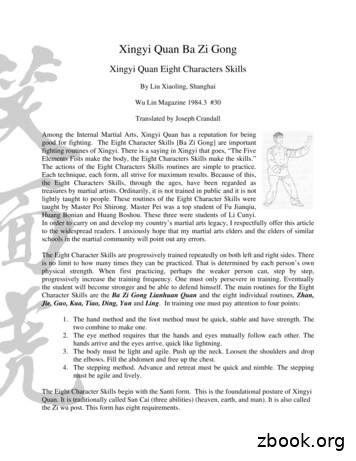Tai Chi Quan: Moving For Better Balance - Washington State Department .
Tai Chi: Moving for Better Balance Community Health Workers Conference April 12, 2018. Lynnwood, WA Julie Cauthorn, DPT
Objectives What is TCMBB? Application in Communities Experience Moving for Better Balance
Fuzhong Li, PhD Quintessential researcher Tai Chi since 1999 over 15 years grant funding from NIH and CDC List of publications www.tcqmbb.com Oregon Research Institute Systematic, ongoing research Collaboration with PTs for specific BALANCE focus. Jan Voit, Moving for Better Balance trainer
Overview Balance training program Enhancement of traditional Tai Chi movements are transformed and reconfigured therapeutic activities for improved balance
Program Basics Eight Form core routine Adapted from contemporary 24 form Tai Ji Quan routine Built in Exercise variations Mini Therapeutic movements subroutine Together create a simple, functional, set of Tai Chi based moves
Evidence Based Tai Chi and fall reductions in older adults 2005 landmark study, randomized controlled trial "Tai Chi and postural stability in patient's with Parkinson's Disease" "Implementing evidence based fall prevention program in outpatient clinical setting" "Tai Ji Quan and global cognitive function in older adults with cognitive impairment" "The effects of Tai Ji Quan training on limits of stability in older adults" "Preventing falls after cancer: tai chi versus strength training"
Endorsement American and British Geriatric Societies Administration on Aging/ National Council on Aging Centers for Disease Control and Prevention Funding through 2019 from Centers Disease Control All Tai Chi programs are not equal specifically designed program reproducible evidence based
Fall Prevention In US one third of people over age 65 fall each year 2-3 times more likely to fall again 10-20%of falls cause serious injuries falls are leading cause of hospitalizations In WA 1 in 5 over age 65 report a fall in past 3 mos Fall frequency increases with age Cycle: fall - fear of falling - decreased activity increased risk of falling - fall
Physical ActivityFall Prevention Research demonstrates Physical Activity is the single most effective strategy for fall prevention. Most effective Physical Activity at least 50 hours to have effect on reducing falls must be challenging balance exercises
Cost Effective CDC cost-benefit analysis: best return on investment. Reduce falls. Save money No equipment required Portable and scalable acute care, inpatient rehab, clinic, community
Outcome Measures Functional reach Berg Balance Scale Romberg Timed Up and Go Falls Efficacy Scale – self report fear of falling Gait speed Limits of Stability - Force plate
Multisystem Training musculoskeletal cognition sensory integrated experience improved functional tasks reduced falls
Training Goals Improve strength balance gait functional mobility multitasking cognition Reduce fear of falling risk of falling
Training Goals Postural stability static and dynamic Mindful control of positioning in space Functional walking activities Movement symmetry and coordination Ankle range of motion Lower extremity strength
Training Emphasis Trunk driven movements Ankle sway Weight shifts Ankle joint movements; heel strike, heel pivot, push off Eye-head-hand coordination Anticipatory and compensatory postural control Various cueing strategies, cognitive challenge
Flexible Program Seated Sit to stand Chair-supported Unsupported Variety of challenges at each step Fun and easy to progress Home exercise program
Eight Form Routine Form One: Move a Ball Form Two: Part Wild Horse’s Mane Form Three: Single Whip Form Four: Wave Hands Like Clouds
Eight Form Routine Form Five: Repulse Monkey Form Six: Brush Knees Form Seven: Fair Lady Works at Shuttles Form Eight: Grasp Peacock’s Tail
Mini Therapeutic Movements Body sway around ankle joints Eye-head movements Sit to and from stand Step and turn Chair up and walk Multidimensional head movements
Mini Therapeutic Movements Single leg stance with Brush Knee Stepping exercises Pushing hands Sensory integration exercises Stepping maneuver around a chair
Current and Future Projects Ongoing research including "Translating an effective falls prevention program into community based practice" program dissemination through community based senior service providers. funded through 2019 Ongoing trainings Partnership with Dept of Health: continue to train new instructors Courses for community instructors and healthcare workers
Summary Evidence based Balance Training Program Fuzhong Li, Oregon Research Institute, ongoing research Application in acute care, inpatient rehab, outpatient, home health, community classes Fun and effective for mind and body
In Your Community Refer Older Adults to current classes Take a course and become an instructor Educate peers on the value of Tai Chi for fall prevention
Resources Washington site: www.betterbalance.net Contact: jan@betterbalance.net, info@betterbalance.net National site: www.tjqmbb.org Thank you!
Questions? Thank you!
Evidence Based Tai Chi and fall reductions in older adults 2005 landmark study, randomized controlled trial "Tai Chi and postural stability in patient's with Parkinson's Disease" "Implementing evidence based fall prevention program in outpatient clinical setting" "Tai Ji Quan and global cognitive function in older adults with cognitive impairment"
The origins of Tai Chi philosophy 27 Tai chi chuan—the origins in a nutshell 29 Chang Sanfeng 29 Chen Wangting 30 Tai chi chuan Classics 31 The role of tai chi chuan in Anan-Do method 31 So, you are a beginner? 33 Why would you want to learn tai chi chuan, anyway? 34 How it works 35 Soft or tense 35
Tai Chi, short for T'ai Chi Ch'uan, is a Chinese martial art, which has been created to increase wisdom and bravery. The term Tai Chi encompasses . The physical techniques of Tai Chi are described in the Tai Chi classics "The Essence of T'ai Chi Ch'uan", a set of writings by traditional masters.
Xingyi Quan Ba Zi Gong Xingyi Quan Eight Characters Skills By Liu Xiaoling, Shanghai Wu Lin Magazine 1984.3 #30 Translated by Joseph Crandall Among the Internal Martial Arts, Xingyi Quan has a reputation for being good for fighting. The Eight Character Skills [Ba File Size: 1MBPage Count: 26Explore furtherXing Yi Quan Pdf - Fill and Sign Printable Template Online .pdf - Google Drivedocs.google.comThe Mysterious Power Of Xingyi Quan ebook PDF Download .www.melbhattan.comThe Study Of Xing Yi Quan [PDF] Download Full – PDF Read .www.readbookpage.comXing Yi Quan PDF Chinese Martial Arts East Asian .www.scribd.comRecommended to you b
trien9 khai thirc hien cac noi dung danh gia cua Chi sor PAPI, trong do phan cong cu the trach nhiem cua co quan, don vi chu tri thuc hien timg tieu chi, tieu chi thanh phan cua Chi so PAPI. Voi vai tro la co quan thuong true giup UBND tinh trien khai cac nhiem vu lien quan denr Chi sor PAPI
Tai Chi and fall reductions in older adults 2005 landmark study, randomized controlled trial "Tai Chi and postural stability in patient's with Parkinson's Disease" "Implementing evidence based fall prevention program in outpatient clinical setting" "Tai Ji Quan and global cogn
Tai Chi App Proposal February 4, 2020 4 VISION Vision Statement For students of Tai Chi Who have difficulty practicing the set at home, The Tai Chi companion app Is a natural language Tai Chi guide That verbally guides you through the set Unlike other apps that require you to break form to interact with a screen. Opportunity Learning
2. Tai Chi as an Inspiration in the Existing Compositions 43 3. Tai Chi and New Music: Case of Angel and Demon (2011) 47 3.1 Purpose and Motivation 48 3.2 Motives and Analysis 48 3.3 Applied Tai Chi Movements in Angel and Demon 50 3.4 Discussion 51 3.5 Summary 51 4. Tai Chi and New Music: Case of Bits of Peace (2014) 52 4.1 Purpose and .
Andreas M unch and Endre S uli Mathematical Institute, University of Oxford Andrew Wiles Building, Radcli e Observatory Quarter, Woodstock Road Oxford OX2 6GG, UK Barbara Wagner Weierstrass Institute Mohrenstraˇe 39 10117 Berlin, Germany and Technische Universit at Berlin, Institute of Mathematics Straˇe des 17. Juni 136 10623 Berlin, Germany (Communicated by Thomas P. Witelski) Abstract .























